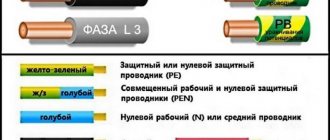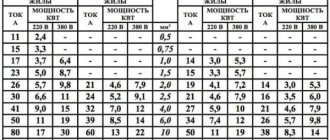A rational power supply scheme depends on a technically sound selection of transformer power, which affects operating costs and payback, which is possible in 6–10 years.
When choosing a transformer, they are guided by the following criteria:
- Power supply category
– the number of transformers is determined. Objects of power supply category III – one transformer. Objects of II and I categories of power supply - two or in some cases three transformers. - Overload capacity
- determination of the power of the transformer. - Daily load distribution schedule
– recording loads by time and days of the week. - Economical mode of operation of the plant.
Calculation of electrical loads of a transformer substation
In the technical conditions of power supply, the need to control an existing transformer substations for additional load is increasingly encountered.
How can this be done? Now I will tell you everything and present my simple program, which will take on part of the work. Methodology for calculating loads on the power supply line of a transformer substation.
City substations are used to power residential and public buildings and premises.
The most difficult thing in this calculation is collecting the initial data.
First of all, in electrical networks it is necessary to connect an electrical circuit to the transformer transformer. Unfortunately, this diagram does not indicate the design possibilities, but only the names (addresses) of the associated objects.
If the house is old, finding documentation for this house is not so easy.
Alternatively, you can go to the website and see how many apartments are in a residential building. For each house we have a property passport, which contains information about the number of apartments. It should be taken into account that large houses can be divided into several sections and can be connected by several TPs.
Having collected (calculated) the estimated capacity of each building, you can proceed directly to the calculation.
What is the essence of the calculation?
If we have a two-transformer substation, we need to check the emergency mode for permissible overloads of the emergency transformer, i.e. calculate the load factor of the emergency transformer. If the transformer allows overloads taking into account the additional (design) load, the transformer substation cannot be replaced by transformers.
The design load of a transformer substation can be obtained using the formula:
Р = zd.max + K1 · Рzd1 + K2 · Рzd2 +… + Кн · Рzd.n,
where Rzd.max is the largest electrical load of buildings supplied from the line (transformer substation), kW;
Rzd1,..., Rzd.n - calculated electrical load of each building (1,..., n), with the exception of the building with the highest load Rzd.max, powered from one line (transformer substation), kW;
K1,. Кн - coefficients of mismatch of maximum electrical loads, taking into account the share of electrical loads of public buildings (premises) and residential buildings (apartments and energy consumers) in the highest design load Pzd.max, taken according to table 19 (TKP 45-4.04-149-2009) or table 6.13 (SP 31-110-2003).
To make it clearer, I’ll take a simple example. Let's say we have two residential buildings: a residential building with electric stoves - 100 kW and a residential building with gas stoves - 70 kW.
Pp = 100 + 0.9 * 70 = 163 kW, K1 = 0.9 - selected from the table.
But there is a nuance in this calculation that nothing is said about.
For example, there are 3 houses with gas stoves:
1100 apartments, Rud = 1.13 kW;
2100 apartments, Rud = 1.13 kW;
3200 apartments, Rud = 1.03 kW;
We will simplify the calculation and will not take into account elevators and other small loads.
P (100) = 113 kW, p (200) = 206 kW.
We calculate the load using our calculation method:
I believe that such a calculation gives an overestimated design capacity, and when calculating houses of the same type it is necessary to combine them into one building.
400 apartments - Rud = 0.95, which means Rr = 0.95 * 400 = 380 kW.
Despite the fact that my thoughts differ somewhat from the proposed methodology of regulatory documents, I believe that this would be more correct.
Of course, it is absolutely forbidden to combine apartments with electric and gas stoves.
This is called calculation manipulation.
To speed up the calculation, I made a simple program. The appearance is shown below:
TP load calculation program
Calculation example
For example, there is a pellet production enterprise that has the following equipment installed:
- mill for grinding wet sawdust;
- dryer drum;
- mill for grinding dry sawdust;
- mixer for moistening wet sawdust;
- granulator.
The planned and actual volume of raw materials that passes through this equipment is presented in the table (download table in Excel).
Table 1. Plan/actual production
| Plan/fact of production, cubic meters. m | May 01-10 | May 10-20 | May 20-31 | Total for the month | ||||||||
| Plan | Fact | CMM | Plan | Fact | CMM | Plan | Fact | CMM | Plan | Fact | CMM | |
| Mill for grinding wet sawdust | 300 | 250 | 83,33 | 300 | 230 | 76,67 | 300 | 240 | 80 | 900 | 720 | 80 |
| Dryer drum | 400 | 250 | 62,50 | 400 | 230 | 57,50 | 400 | 240 | 60 | 1 200 | 720 | 60 |
| Mill for grinding dry sawdust | 350 | 250 | 71,43 | 350 | 230 | 65,71 | 350 | 240 | 68,57 | 1 050 | 720 | 68,57 |
| Mixer for moistening wet sawdust | 350 | 250 | 71,43 | 350 | 230 | 65,71 | 350 | 240 | 68,57 | 1 050 | 720 | 68,57 |
| Granulator | 300 | 250 | 83,33 | 300 | 230 | 76,67 | 300 | 240 | 80 | 900 | 720 | 80 |
| Total: | 1 700 | 1 250 | 73,53 | 1 700 | 1 150 | 67,65 | 1 700 | 1 200 | 70,59 | 5 100 | 3 600 | 70,59 |
Thus, the drying drum has the highest productivity, so its CMM is lower, because other types of equipment are not designed for such loading. Therefore, the drum can be loaded more and has additional power potential. The granulator and mill for grinding wet sawdust are the most loaded in relation to their potential: 80%. Although 80% is a good power rating, it can be increased because... there is still 20% to grow.
Load calculation
Before calculating transformer substations, you should know that their power “P” is determined as the sum of the loads on the input busbars of all connected consumers.
Important! This indicator should be calculated taking into account the simultaneity factor.
The latter is introduced as a correction factor for existing networks with a voltage of 380/220 Volts and is indicated in special tables (see below).
Calculating the power of a transformer substation for each section of the line means taking into account all the same type of loads connected simultaneously and with approximately the same energy consumption values. However, in a real situation, these indicators are distributed completely differently, which is reflected in seasonal, annual and daily charts.
A very good confirmation of this is the amount of reactive power (as a component of total consumption), which increases significantly at night. For most private and public facilities, this is due to the fact that gas-discharge street lighting lamps are turned on at night, as well as service lighting in public buildings.
Additional information: This calculation also takes into account peak and unbalanced demand values associated with large inductive loads (such as electric motors).
To power rural settlements and gardening partnerships, where a mixed type of load predominates, one or two 10 / 0.4 kV transformer substations with a power of up to 10 kVA are sufficient. When choosing the type of distribution board for urban areas, preference is given to package transformer substations with a “P” value of up to 160 kVA. The indicated efficiency indicators are fixed mainly by the power of the transformers used in the transformer substations.
Simple explanation
Let's not delve into boring definitions and formulas, but let's look at the question in a simple way. And first of all, let’s figure out what kind of power our electrical appliances consume.
So, first, understand that not every electrical appliance that operates on AC power spends all the absorbed power on doing useful work - heating, lighting, sounding music speakers, etc.
The load can be divided into four main types and all of them can be connected directly to the transformer.
Resistive load
A striking representative of this type of load is the most common electric kettle or iron, in which a heating element heats up when an electric current passes through it.
In fact, a heating element is nothing more than resistance, and here it is absolutely unimportant how the current flows through it. Everything is simple here: the greater the current flows, therefore the greater the heating, which means that absolutely all the power is spent on this process.
So the power expended on a resistive load is called active. This is exactly the load that is measured in kW.
Inductive load
An example of an inductive load is the most common electric motor. When current passes through an electric motor, not all the energy is spent on rotation.
A certain part goes to create an electromagnetic field and is also dissipated in the conductor. This component of power is called reactive power.
It is not spent to perform the work directly, but is needed for the equipment to fully function.
Capacitive load
This is a special case of the reactive component of power. As you know, a capacitor works on the principle: it accumulates a charge and releases a charge. This means that inevitably part of the power is spent on the accumulation and transfer of charge and is not directly involved in useful work.
So now it is extremely difficult to find an electrical appliance at home that does not have at least a couple of capacitors.
Mixed load
Well, everything is extremely simple here. A mixed load has all the components described above. And 99 out of 100 electrical appliances are exactly like that.
So the total power consists of a reactive and active component, and it is the total load that is measured in kVA.
Transformer manufacturers cannot determine in advance what type of load will be connected and where exactly their product will be used. Therefore, the technical parameters indicate the total power for a mixed type of load.
Important to remember.
Many manufacturers indicate the power of the device in kW, but they also indicate the power factor K. So, to find out the total power of the device, you need to remember a simple formula:
Let's look at a simple example for better understanding. Let's say you purchase a drill and its power, according to the technical data, is 3 kW. But the power factor is 0.8.
So, knowing these data, you can calculate the total power of the drill:
S = 3/0.8 = 3.75 kVA
It is this value that the drill will load our transformer with.
Transformer performance optimization
To optimize the operation and reduce the cost of transformer substations, the following technical measures are taken:
- Circuits are used where switches cannot be installed on the higher voltage side.
- Transformers installed in a workshop should not have distribution boards on the overvoltage side.
- When installing a radial power circuit, the power cable is connected directly to the transformer.
- When using a mains power supply, the power cable is connected through a switch or load break switch.
Substation design
The main functional unit of the transformer substation is a step-down transformer, for the normal operation of which the following equipment is provided in the substation:
- high-voltage protection devices (arresters and punches);
- switches of various types;
- surge suppressors;
- current and voltage transformers;
- linear bus sections;
- instruments for taking readings and metering electricity.
In addition, any substation contains control devices, power supply systems for its own needs and other auxiliary equipment.
Selection of measuring current transformers - main characteristics
The article describes the main parameters of current transformers.
Transformation ratio
Rated transformation ratio is the ratio between the rated primary winding current and the rated secondary winding current, which is indicated as an irregular fraction on the rating plate.
The most commonly used instrument transformers are x/5A, most instruments have a higher accuracy class of 5A. For technical and especially economic reasons, for long measuring lines it is recommended to use x transformers / 1 A. The line losses in 1 A transformers are only 4% of 5 A transformers. But in this case, the measuring instruments usually have a lower accuracy class.
Rated current
Rated or rated current (previously used name) is the primary and secondary current (primary rated current, secondary rated current) indicated on the nameplate for which the transformer is rated. Rated currents (excluding classes 0.2 S and 0.5 S) are 10 - 12.5 - 15 - 20 - 25 - 30 - 40 - 50 - 60 - 75 A, plus numbers derived from these values multiplied by multiples quite often.
Rated secondary currents are 1 and 5 A, preferably 5 A.
The normalized current ratings for classes 0.2 S and 0.5 S are 25-50-100 A, as are the numbers obtained from these values by multiplying by ten, the secondary current is (only) 5 A.
The correct selection of the primary current rating is very important for measurement accuracy. It is recommended that the ratio closest to the measured/set current (In) be as close to the maximum as possible.
Example: In = 1,154 A; selected ratio = 1,250/5.
The rated current can be determined under the following conditions:
- Instrument transformer current rating multiplied by 1.1 (transformer with closest specification)
- Fuse (fuse rated current = transformer rated current) of the metering part of the installation (low voltage main distribution boards, distribution cabinets)
- Rated effective current multiplied by 1.2 (this method should be used if the effective current is significantly less than the rated current of the transformer or fuse)
It is not recommended to use transformers with overrated values, since in this case the measurement accuracy can be significantly reduced at relatively low currents (compared to the rated primary winding current).
Rated power of current transformers
The current transformer rating is the result of the meter load and the quadrant of the secondary winding current rating and is measured in VA. Standardized values are 2.5 - 5 - 10 - 15 - 30 VA. Depending on the application, values greater than 30 VA can also be selected. The power rating describes the ability of a transformer to pass secondary current, within acceptable limits, through the load.
When choosing the appropriate power, the following parameters must be taken into account: power consumption of metering devices (for serial connection), cable length, cable cross-section. The longer the cable and the smaller its cross-section, the greater the losses in the power line, i.e. the rated power of the transformer must be adequate.
The concept of installed and estimated capacity
The installed power corresponds to the nominal values and is a fixed technical indicator of the installation or system. For enterprises, it can be regulated, for example, by decommissioning some electrical installations. This value is used to characterize:
- separate enterprise and building;
- industry group;
- geographical area and the entire country.
The installed power value refers to the active power indicator or total.
One of the fundamental factors during the design of an electrical installation is the calculation of the power required for its long-term and uninterrupted operation. When they define what design power is, this is the value they have in mind.
The values of installed and calculated power are interconnected when performing various design work. The value of the design power is usually determined on the basis of the installed power (i.e. the sum of the rated power of the electrical consumers available in the part of the electrical installation in question) after taking certain factors for the simultaneous connection of these loads.
Peak power is the highest average load measured or calculated over a specified period of time (for example, during a day, a week, a month, a year). Most often the period covers one year.
Important! The peak power indicator is the basis for choosing power equipment from the point of view of heating by operating current, and determines the settings of the applied protection.
At the design stage it is usually assumed that the design power is equal to the peak power and a fixed power factor is taken.
The design power is determined based on the following dependencies:
- maximum rated current:
I = P /√3 x U cos φ.
- tan φ = Q/P;
- estimated total power:
S = √(Р² + Q²).
Table of KTP TP transformer power substations
A rational power supply scheme depends on the technically correct choice of transformer power, which affects operating costs and depreciation, which is possible after 6-10 years.
When choosing a transformer, they are guided by the following criteria:
- Power supply category: the number of transformers is determined. Objects of power category III - transformer. Power categories II and I: two, and in some cases three transformers.
- Overload capacity - determination of the power of the transformer.
- Daily load distribution schedule - recording loads by hours and days of the week.
- Economical mode of operation of the plant.
Suction power – 0.2 – 0.48 kW
200 – 480 W – this is the range in which the normal suction power is located, and how strongly the vacuum cleaner will draw in air with dust and debris depends on this. It is this parameter that determines the efficiency of the device, and it is always lower than consumed. If you are hesitating between two similar devices, choose the one where this parameter is higher - such a vacuum cleaner will be better at pulling dust.
For a small apartment, it is enough to purchase a device with a suction power of 250 - 300 W
If you want to effectively clean even deep carpets, then it is better to pay attention to models with 480 W suction
Modular complete transformer substations in a concrete shell (BKTPB "INVEL")
BKTPB "INVEL" is designed to receive three-phase alternating current electricity with a frequency of 50 Hz, voltage 6 (10.20) / 0.4 kV and power from 25 kVA to 6300 kVA. BKTPB are used to supply energy to industrial, infrastructure, housing and municipal formations, as well as rural settlements and public development areas (TP, RTP, RP).
The power and output lines are made by cable. Cable entry is carried out from the ground through a cable structure. If it is necessary to connect a complete transblock to an overhead line (VL), a cable gland with cross-linked polyethylene insulation is used with an output to the overhead line support.
BKTPB "INVEL" is available in different types:
single-transformer electrical substations (BKTPB "INVEL") *
it is made of different concrete shells: the left side - the entrance to the distribution compartment is to the left of the transformer compartment gate and the right side - the entrance to the distribution compartment is to the right of the transformer compartment gate.
electrical substations with two transformers (2BKTPB "INVEL") *
It consists of right and left blocks. In addition, the 2BKTPBs are made with a subscriber portion, allowing the RUVN and LVNN to be placed in two different blocks with separate inputs.
* - production of transformer substations in a concrete shell with an unlimited number of transformers and number of modules
electrical distribution substations (BKRTPB "INVEL").
They can consist of a virtually unlimited number of modules connected to a common service corridor.
two-story substation (2e2BKTPB "INVEL")
The application represents an optimal solution from both a technical and economic point of view by reducing the construction, installation and commissioning time in cases of small land area intended for the construction of a substation due to the building density or if it is necessary to dismantle an existing substation adapt to the ground in order to increase the number and power of power transformers and the number of output lines.
small substations (MBKTPB "INVEL")
The power of BKTPB is limited and ranges from 25 to 630 kVA. Overall dimensions do not exceed 3000x2480x2970 (LxWxH). This substation is ideal where development is limited.
traction substations for supplying ground transport (TBTPB "INVEL")
Traction substations for ground electric transport (tram, trolleybus, railway) have been implemented on the basis of BKTPB. At the same time, traction substations based on BKTPB can significantly reduce the building area, capital investments, installation and commissioning time. Therefore, traction substations based on BKTPB are the most acceptable solution, especially if they are located within populated areas. With a monoblock design, the BKTPB building consists of 7 modules, the number of units can reach 3, with a proportional increase in the number of modules used.
underground substation (PBKTPB "INVEL")
In densely populated areas of modern cities, it is difficult to find space for new substations. The space for construction is so limited that they can only be installed next to residential or underground buildings. Underground transformer substations solve this problem.
An underground substation can be installed in any suitable location: in a park, under a playground, in a basement, etc. This will be a safe solution for both people and the environment.
Installation and commissioning of INVEL BKTPB must be carried out by a specialized installation organization. If necessary, installation and configuration of the BKTPB can be carried out by the INVENT-Electro engineering and service department.
Determination of power transformer power
To manufacture transformer power supplies, a single-phase power transformer is required, which reduces the 220-volt AC network voltage to the required 12-30 volts, which is then rectified by a diode bridge and filtered by an electrolytic capacitor.
These transformations of electrical current are necessary since any electronic equipment is assembled on transistors and microcircuits, which usually require a voltage of no more than 5-12 volts.
To assemble a power supply yourself, a novice radio amateur needs to find or purchase a suitable transformer for the future power supply. In exceptional cases, the power transformer can be made independently. Such recommendations can be found in the pages of old books on electronics.
But now it’s easier to find or buy a ready-made transformer and use it to make a power supply.
Complex calculation and independent production of a transformer for a beginning radio amateur is a rather difficult task, but there is another way out. You can use a used but repairable transformer. A low-power power supply with a power of 7-15 W is enough to power most homemade designs.
If the transformer is bought in a store, then, as a rule, there are no special problems with selecting the necessary transformer. The new product indicates all its main parameters, such as power, input voltage, output voltage, as well as the number of secondary windings, if there is more than one.
But what if you come across a transformer that has already worked in any device, and you want to reuse it to create your own power supply? How to determine the power of a transformer, at least approximately? The power of the transformer is a very important parameter, since the reliability of the power supply or other device that you have assembled will directly depend on it. As you know, the power consumed by an electronic device depends on the current it consumes and the voltage required for its normal operation. Approximately this power can be determined by multiplying the current consumed by the device (In by the supply voltage of the device (A). I think many are familiar with this formula from school.
, where Un is voltage in volts; In - current in amperes; P is power in watts.
Let's look at determining the power of a transformer using a real example. We train on the TP114-163M transformer. This is an armored transformer, which is assembled from W-shaped and straight stamped plates. It should be noted that transformers of this type are not the best in terms of efficiency. But the good news is that such transformers are common, often used in electronics, and can be easily found on the shelves of radio stores or in old and faulty radio equipment. In addition, they are cheaper than toroidal (or, more simply put, ring) transformers, which have high efficiency and are used in fairly powerful radio equipment.
So, before us is the transformer TP114-163M. Let's try to roughly determine its power. Let's use the recommendations of the popular book by V.G. Borisov "Young Radio Amateur".
To determine the power of a transformer, it is necessary to calculate the cross-section of its magnetic circuit. As for the TP114-163M transformer, the magnetic core is a set of W-shaped straight printed plates made of electrical steel. Then, to determine the cross-section, it is necessary to multiply the thickness of the set of plates (see photo) by the width of the central lobe of the W-shaped plate.
When calculating, you must respect the size. It is best to measure the thickness of the set and the width of the central petal in centimeters. Calculations must also be made in centimeters. Thus, the thickness of the transformer unit under study was about 2 centimeters.
Then measure the width of the center petal with a ruler. This is a more difficult task. The fact is that the TP114-163M transformer has a narrow set and a plastic frame. Therefore, the central petal of the W-shaped plate is practically invisible; it is covered by the plate and it is quite difficult to determine its width.
The width of the center petal can be measured from the very first W-shaped plate in the space between the plastic frame. The first plate does not end with a straight plate, so the edge of the central lobe of plate W is visible. Its width was about 1.7 centimeters. Although the calculations presented are approximate, it is still desirable to make measurements as accurately as possible.
We multiply the thickness of the magnetic circuit (2 cm) by the width of the central lobe of the plate (1.7 cm). We get the cross-section of the magnetic circuit - 3.4 cm 2. Next we need the following formula.
, where S is the cross-sectional area of the magnetic circuit; Ptr—transformer power; 1.3 is the average coefficient.
After several simple transformations, we obtain a simplified formula for calculating the power of a transformer based on the cross-section of its magnetic core. Here she is.
We substitute into the formula the value of the cross section S = 3.4 cm 2, which we obtained earlier.
How to find out the power of the device
You can do this in several ways:
- Look in the technical data sheet or on a special sticker (label) on the device. The latter is usually located on the back wall or base.
- View specifications for the device model on the Internet.
- Using an electricity meter. It is necessary to turn off all other current consumers, measure the indicator, then turn on the desired device and wait 15 minutes. Then measure the indicator again and multiply the resulting difference by 4. The result is current consumption per hour.
Using a meter you can measure approximate power
- Using Ohm's law: P = U2 / R, where U is the voltage of 230 V, and R is the resistance that must be measured with the tester.
- Wattmeter: This is a meter that is an “adapter” between the outlet and the device. When turned on, the exact value will appear on the indicator.
The manufacturer usually indicates the maximum power - the equipment will not consume more than this value. In its normal state, the device requires less energy; when calculating, it is worth taking the maximum value.
If you determine it yourself, you will get an average number - this is how much equipment consumes on average. This number should be increased slightly so that there is a small margin left.
When determined using a wattmeter, the figure turns out to be extremely accurate - this is how much current the device consumes at a particular moment. The value should also be increased slightly.
A wattmeter allows you to accurately determine the amount of electricity
The power consumption of equipment is an important value that shows how much electricity is consumed. This value is necessary for the correct and safe operation of the electrical network: if the power of the device and the outlet does not match, a short circuit or fire may occur.
Groups and wiring diagrams
The criteria for selecting a group of electrical connections of different phases of windings to each other are:
- Minimization of higher harmonic levels in networks. This is relevant when the share of nonlinear consumer loads increases.
- When the transformer phases are asymmetrically loaded, the currents of the primary windings must be equalized. This stabilizes the operation of electrical networks.
- When powering four-wire (five-wire) networks, the transformer must have a minimum zero-sequence resistance for short-circuit currents. This makes it easier to protect against ground faults.
To comply with the conditions of clauses 1 and 2, one winding of the transformer is connected to one star while connected to the other in the form of a triangle. When providing four-wire networks, the Δ / Yo circuit is considered the best option. The low voltage windings are connected in a star with the neutral terminal being brought out, used as a PEN conductor (neutral wire).
The Y/Zo circuit has even better characteristics, in which the secondary windings are connected in a zigzag pattern with a zero terminal.
The Y/Yo scheme has more disadvantages than advantages and is rarely used.
How to choose a power transformer by power
It is not always enough to collect and analyze the consumer power provided by the transformer.
For manufacturing enterprises, they follow the procedure for commissioning equipment. This takes into account that all consumers cannot be turned on at the same time. However, a possible increase in production capacity is also taken into account.
Therefore, when calculating and choosing the power of a power transformer, they are guided by the schedule of the active daily and total average load of the substation, as well as the duration of the maximum load. If a transformer is designed that will participate in the power supply of residential infrastructure, then the season is also taken into account. In winter, the load increases due to the inclusion of electric heating, in summer - air conditioning.
Table No. 1 - Selection of power transformer based on permitted power and emergency loads
| Load type | Load ranges (kVA) for transformers with power (kVA) | |||||||
| 25 | 40 | 63 | 100 | 160 | 250 | 400 | 630 | |
| Industrial consumers, families, workshops for servicing agricultural equipment, construction, vegetable storage, water supply pumping stations, boiler houses | up to 42 | 43-68 | 69-107 | 108-169 | 170–270 | 271-422 | 423-676 | 677-1064 |
| Consumers of public services and administrative enterprises (schools, clubs, canteens, bathrooms, shops) combined with residential buildings | up to 44 | 45-70 | 71-110 | 111-176 | 177–278 | 279-435 | 436-696 | 697-1096 |
| Rural residential buildings, groups of rural residential buildings (usually one-story) | up to 45 | 46-72 | 73-113 | 114-179 | 180–286 | 287-447 | 448-716 | 717-1127 |
| Community of consumers of urban settlements and cities of regional subordination | up to 43 | 44-68 | 69-108 | 109-172 | 173–270 | 271-422 | 423-676 | 677-1064 |
| Residential buildings, urban settlements type and city of regional subordination | up to 42 | 43-68 | 69-107 | 108-170 | 171–273 | 274-427 | 428-684 | 685-1077 |
| Mixed load with a predominance (more than 60%) of industrial consumers | up to 42 | 43-67 | 68-106 | 107-161 | 162–257 | 258-402 | 403-644 | 645-1014 |
| Mixed load with a predominance (more than 40%) of domestic consumers | up to 42 | 43-68 | 69-107 | 108-164 | 165–262 | 263-410 | 411-656 | 657-1033 |
In the absence of accurate information, the active load is determined by the formula:
Snom ≥ ∑ Pmax ≥ Pp;
Where ∑ Pmax is the maximum active power;
Pp is the design power of the substation.
If the substation operating schedule is characterized by a short-term peak power mode - 30 minutes or no more than 1 hour, the transformer will operate in underload mode. Therefore, it is more profitable to choose a transformer with a power close to the maximum continuous load and fully use the overload capabilities of the transformer, taking into account systematic overloads in normal mode.
In real conditions, the permissible overload value is determined by the initial load factor. The choice of load size is influenced by the ambient temperature in which the operating transformer is located.
The load factor is always less than one.
Kn = Pc / Pmax = Ic / Imax; where Pc, Pmax and Ic, Imax are the daily and maximum average power and current.
Table No. 2 - Recommended load factors for power transformers in the transformer shop. The coefficient limits the transformer overload, leaving a certain power reserve.
| Transformer load factor | Type of transformer substation and nature of the load |
| 0,65… 0,7 | Transformer substations with two transformers with predominant load category I |
| 0,7… 0,8 | Single-transformer transformer substations with a predominant load of category II in the presence of mutual redundancy in jumpers with other substations for secondary voltage |
| 0,9… 0,95 | Transformer substation with a load of category III or with a predominant load of category II with the possibility of using a warehouse reserve of transformers |
Table 3 - the duration and degree of overload in emergency modes with forced oil cooling are set by factory parameters. Electrical systems PTE and PTB TB. EP-4-1
| Loads in fractions of rated current | Allowable duration, min | |
| Transformers in oil bath | Dry transformers | |
| 1.2 1.3 1.4 1.5 1.6 1,75 2,00 | — 120 90 70 45 winds 10 | 60 45 32 18 5 — — |
The nature of the daily load is equivalent to the ambient temperature, the time constant of the transformer, the type of cooling, periodic overloads are allowed.
Figure 1 - Design load graph. 1 - daily allowance upon the fact; 2 - two-stage analogue of the actual
According to the graph, the initial load period is characterized by operating the transformer at rated load for 20 hours and an initial load factor of 0.705.
The second period is the overload factor kper = 1.27 and the time is 4 hours. This means that the overloads are determined by the load program converted into an equivalent program taking into account heat. The permissible load of the transformer depends on the rated load, its service life and the maximum peak load, determined by the excess load factor:
kper = Ie max / Inom
initial load factor
kn.n. = That is / Inom
That is, max is the maximum equivalent load;
Those. — equivalent initial load.
Overloads of transformers are allowed, but their capabilities: time and amplitude are limited by the standards established by the manufacturer. PTEEP Rules, Ch. 2. 1.20 and ch. 2. 1. 21 limit the transformer overload to 5%.
Table 4 - Overload over time for oil-filled transformers
| Overload value, % | thirty | 45 | 60 | 75 | 100 |
| Duration, min. | 120 | 80 | 45 | winds | 10 |
Table 5 - Overload time for dry transformer
| Overload value, % | winds | thirty | 40 | 50 | 60 |
| Duration, min. | 60 | 45 | 32 | 18 | 5 |
The ventilation of the electrical installation work room must ensure heat removal so that in case of overload and maximum air temperature, the heating of the transformer does not exceed the permissible value. Often in warm conditions in fields far from populated areas, natural ventilation is used by opening the transformer compartment doors.
The PUE rules allow a maximum post-emergency overload of the transformer up to 40% for a period of no more than 6 hours within 5 days.
Design power for industrial facilities
Reactive power
The design capacity of an industrial enterprise depends on:
- type of product;
- technologies used;
- expected maximum load during the year;
- type of products;
- type of equipment and the degree of its adaptation to technology.
There are many calculation methods, all of them must have common properties:
- ease of calculation;
- versatility in determining loads for different levels of energy consumption and distribution;
- accuracy of results;
- ease of determining the indicators on which the method is based.
The main indicators are calculated using the same formulas, but with different correction factors.
Demand factors for MV substation
For three-phase electric motors, the installed power is:
Р = Рн/(η x cos φ), where:
- Рн – nominal power indicator from the data sheet;
- η – efficiency of the electric motor;
- cos φ – power coefficient.
An increase in the allocated power, according to technical conditions, must be agreed upon with the energy supply organization. For this purpose, recalculations are carried out for input cables and protection devices based on the new installed power. But the decision to allocate depends on the availability of free capacity.
Features of calculating the power of transformers
Typical operating power values for conversion products are strictly standardized and can only take discrete values (from 25 to 1000 W).
To determine the power of substations equipped with typical transformers, it will first be necessary to collect data on the linear loads connected to them. Direct summation of the results obtained in this case is unacceptable, since the distribution of consumption over time is important to obtain the correct indicator.
In apartment buildings, this depends not only on the time of day, but also on the season: in winter, many electric heaters are turned on in apartments, in summer - no less than a number of fans and air conditioners. The values of correction factors introduced to take into account the seasonality of loads for condominiums are taken from special reference books.
Purpose
Before you understand what the power of a substation is, you should understand the purpose of this power plant. A transformer substation (TS) is intended to receive, convert and subsequently distribute energy to consumer loads. The electrical equipment included in its composition must:
- guarantee uninterrupted supply of electricity to ordinary consumers;
- ensure timely redistribution of power between end loads;
- provide for the possibility of expanding the circuit (taking into account the increase in the number of loads).
The operation of the transformer substations is based on the principle of reducing the voltage supplied through high-voltage lines to a level acceptable for delivery to the consumer (380 Volt linear and 220 Volt phase). The main functional indicator of electrical installations of the TP type is their power, sufficient to guarantee the provision of electricity without a “sag” of voltage in the network.
This can be achieved by the correct choice of design parameters of both the station equipment itself and the parameters of distribution lines with loads connected to them.
Technological connection to electrical networks
- Required power calculator - an approximate calculation of the need for electrical power to submit an application for technological connection;
- Cost calculator - approximate calculation of the cost of technological connection to electrical networks, depending on the type of connection (existing or new);
- Connection stages - a detailed description of the main stages required for technological connection to electrical networks;
- Answers of JSC Lenenergo to the most frequently asked questions regarding the technological connection of additional capacity or new capacity and the conclusion of an energy supply agreement.
Two transformer transformer substations
Two-transformer transformer substations with a predominance of electricity consumers of categories I and II are used. In this case, the power of the transformers is selected in such a way that when another transformer goes out of service, taking into account the permissible overload, it will take on the load of all consumers (in this situation, it is possible to temporarily switch off category III electricity consumers). Such substations are desirable regardless of the category of consumers, but in the presence of an irregular daily or annual load schedule.
In these cases, it is beneficial to change the connected power of the transformers, for example, in the presence of seasonal loads, one or two work shifts with significant changes in the shift load.
The power supply of a village, a city microdistrict, a workshop, a group of workshops or an entire enterprise can be provided by one or several transformer substations. The feasibility of constructing a one- and two-transformer substation was determined as a result of a technical and economic comparison of various options for the power supply system. The criterion for choosing an option is the minimum given costs for the construction of a power supply system. The options being compared must provide the required level of power supply reliability.
In the power systems of industrial enterprises, the following unit transformer capacities are most common: 630, 1000, 1600 kVA, in urban electrical networks - 400, 630 kVA. Design and operational practice has shown the need to use the same type of transformers of the same power, since their diversity creates inconvenience in maintenance and causes additional repair costs.
One transformer TP
Single-transformer transformer substations are also advantageous in that if the operation of an enterprise is accompanied by periods of low loads, then due to the presence of jumpers between transformer substations at the secondary voltage, it is possible to turn off part of the transformers, thereby creating an economically sustainable operating mode. By economical we mean an operating mode that guarantees minimal power losses in transformers.
In this case, the problem of choosing the optimal number of serviceable transformers is solved.
Such transformer substations can also be economical from the point of view of bringing the voltage of 6-10 kV as close as possible to power receivers, since due to the decentralization of electrical energy conversion, the length of networks is reduced to 1 kV. In this case, the problem is solved in favor of using two single transformer substations instead of two transformer substations.
Basic principles for choosing a transformer
As a rule, power systems use one or two transformer substations. The use of three transformer substations creates additional capital costs and increases annual operating costs. Three-transformer substations are rarely used, as a forced solution during reconstruction, expansion of a substation, with a separate power supply system for power and lighting loads, or with sudden power supply to variable loads.
Large substations (GPP) mainly use two transformers (two independent power sources), since through such substations it is necessary to provide electricity to consumers of categories I, II and III of power supply reliability.
At different points of receiving electricity at the enterprise at the GPP, as well as when powering the enterprise according to the deep input scheme into the PGV, it is allowed to use one transformer, providing post-emergency power supply to the loads through secondary voltage connections with adjacent substations (PGV, GPZ), with CHP plants or other power plants. For the main power supply of single-transformer PGVs via 35-220 kV lines, it is recommended to connect the nearest substations to different lines or circuits with subsequent use of secondary voltage connections in post-emergency mode.
Single-transformer transformer substations 6-10 / 0.4-0.23 kV are used to power loads that allow power outages for a period of no more than a day, which is necessary for repairing or replacing a failed element (power supply to category III consumers), as well as for power supply consumers of category II, subject to power reservation using jumpers on the secondary voltage or if there is a supply of transformers.
Selecting the number of transformers
Single-transformer substations are used in two cases. Firstly, for objects of category III power supply. Secondly, for consumers who have the ability to back up power supply using ATS (automatic transfer switch) from another power source.
When supplying consumers of categories I and II in emergency mode at a two-transformer substation, after the ATS is triggered, the entire transformer takes on the load of the faulty one. Therefore, its overload capacity should be sufficient to replace a failed transformer. In normal mode, transformers operate underloaded, which is not economically feasible. Therefore, in an emergency, some consumers of category III power supply are disconnected from the network.
The power supply break for category II facilities is limited to one day. To restore the scheme, a strategic warehouse reserve of equipment necessary to eliminate the accident is required. In this case, the power of the new transformer must be identical to the one being replaced. Thus, the amount of backup equipment is reduced.
Types of TP
There are many types of distribution transformer substations, varying in power, location and design. Among them the following main types can be distinguished:
- Transformer substations with a capacity of up to 40 kW for power supply of small objects.
- Powerful distribution complexes used to supply energy to urban areas and large enterprises.
- Complete transformer substations or package substations, built on a modular principle (bl.
Additional information: PTS, in turn, are divided into throughput and dead-end, which are part of the distribution network system.
According to their location, all known types of transformer substations are divided into closed and open station ones. An example of the second type is pole or pole transformer converters.
Power selection in industrial networks
The choice of power in the networks of industrial enterprises is carried out according to the following principles:
- the specific power of transformers is selected based on the recommendations of the specific density of the design load and the total design load of the installation;
- the number of substation transformers and their rated power are determined in accordance with the Guidelines for the design of reactive power compensation in electrical networks of industrial enterprises 3 (see also section 4.3);
- the choice of transformer power should be made taking into account the recommended load factors (Table 3.2) and permissible emergency overloads of transformers (Table 3.3);
- in the presence of standard load circuits, the choice should be made in accordance with GOST 1420985 and taking into account reactive power compensation in networks up to 1 kV.
Installed capacity for power plants
How is power measured?
For power plants, the installed power is calculated by summing the power ratings of the individual generators and their associated motors. Almost always these values are identical. In cases of discrepancy, the calculation is carried out using a lower power.
Installed capacity of Russian power plants
As a result, at expensive stations with high fuel economy, the cost of electricity is extremely dependent on the consumption mode. Therefore, for large stations it is beneficial to use the installed capacity for a maximum of hours per year, and for small gas turbine plants with high fuel consumption, it is more expedient to switch them on during peak load hours, when the total operating time on an annual basis is small.










